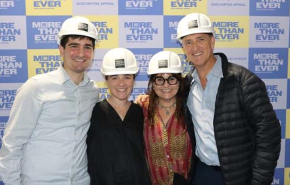Forecasting changes in Australia’s Jewish community
Australia’s Jewish population has reached a demographic turning point, with recent census data showing a significant plateau in growth and significant trends emerging in migration and community demographics.

David Graham
The 2021 Census, conducted by the Australian Bureau of Statistics (ABS), offers a detailed snapshot of the Jewish community, which was estimated to be 116,967 people in 2021, or 0.46% of the national population.
Dr David Graham, a leading demographer and research consultant to the Jewish Communal Appeal (JCA) in Sydney, authored the analysis presented this week at a JCA event. The data reveals a modest 1.2% increase in the Jewish population from 2011 to 2021, a stark contrast to the 19% growth seen in the general population during the same period and to the strong growth experienced by the Jewish community since the 1980s. “The Jewish population likely peaked around 2016 at approximately 118,000, with current data suggesting a slight decline,” said Dr Graham.
One of the most striking shifts highlighted in the census is the change in migration patterns. For the first time in Australian history, migration from Israel has become the largest source of new arrivals within the Jewish community, surpassing traditional sources like South Africa and the former Soviet Union. However, overall migration levels have balanced out, leading to a “net zero” scenario, where the number of new arrivals is roughly equal to those leaving.
The data highlights the aging nature of the Jewish population. With a median age of 44 years—six years older than the general Australian median—there has been a notable increase in the number of Jews aged 70-74. “This aging trend will increase demand for aged care services over the next decade, and proactive planning is essential,” Dr. Graham indicated. Interestingly, the number aged 0-4 decreased by 1,400.
Geographically, 94% of the Jewish population resides in capital cities, with Melbourne and Sydney being the largest hubs. The vast majority (94%) lived in Australia’s capital cities, and 84% lived in either Sydney (approx. 43,738 people) or Melbourne (approx. 53,373).
Caulfield-North in Melbourne’s Inner South remains the most Jewish neighbourhood, with Jews accounting for 49% of the population. Among the largest Jewish communities in Australia, growth was strongest in Bentleigh East in Melbourne seeing a 12% growth, while St. Ives in Sydney experienced a significant 27% decline.
Educational trends within the community are also evolving. The census reports that the proportion of Jewish children attending Jewish schools in Australia declined from 54% in 2011 to 48% in 2021. “This decline may be driven by financial factors or changing family preferences,” noted Dr. Graham, suggesting a need for further research to fully understand the reasons behind this trend.
Financially, the Jewish community stands out, with the median personal income at $59,800—43% higher than the national average. Unsurprisingly, household incomes are similarly elevated, with the median at $134,900. Jewish households show a preference for home ownership, with 38% owning their homes outright compared to 31% of the general population. However, Dr Graham indicated “what was fascinating was that people in Jews in Sydney are twice as likely to live in an apartment as those in Melbourne.”
In terms of community engagement, the Jewish population continues to lead in volunteerism, with 27% having volunteered in the year leading up to the census, nearly double the national rate.
However, the census data is not without its complications. Dr. Graham pointed out that changes in the census format—specifically, the repositioning of the “No religion” option at the top of the religion question—may have inadvertently depressed the reported numbers of Jews. The 2016 census experienced several issues that impacted data collection. These included an attack on the ABS system as well as negative publicity about privacy. In 2021, the COVID-19 pandemic had a significant impact on data collection, particularly in New South Wales, where religion data from aged care homes was not collected, has led to gaps in demographic information.
Despite these challenges, Dr. Graham’s analysis for the JCA, provides crucial insights into the current state of the Jewish community in Australia. “As the community continues to evolve, this data will be essential in ensuring that resources are allocated effectively and that we are prepared for the future,” he concluded.









